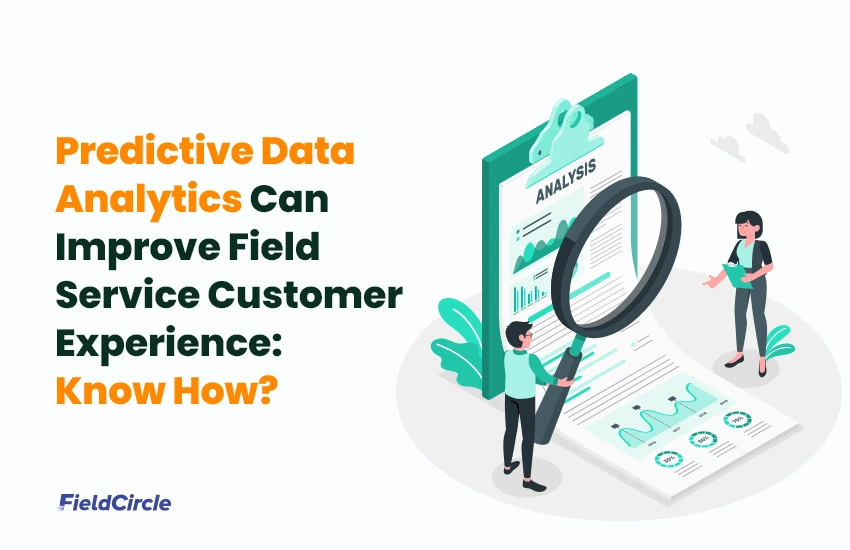Predictive Data Analytics Can Improve Field Service Customer Experience: Know How?

Field service teams now have access to more resources than ever, enabling them to better understand and assist customers. This creates a great opportunity for companies to improve their customer service. However, not all opportunities are equally valuable regarding their potential impact on the customer experience.
The question is, where do you start? Though this is a fundamental question that every industry faces, only a few realize that the answer is hidden within their IT systems. The vast amount of data in multiple IT systems across the business holds the answer. According to a study by INC, approximately 73% of organizational data remains untapped for further analytics in a typical company. This is where analytics can create new dimensions for customer satisfaction. Customer data is one of the most beneficial resources companies can leverage to improve customer service. Big data and analytics have revolutionized how services are delivered worldwide. Field service businesses must closely monitor their customers’ satisfaction levels, as high scores on this index are essential for any business’s organic growth and scalability.
If you are not leveraging customer data in your service approach, read on. This post will help you understand how the predictive approach differs from predictive and reactive field service and highlight how using customer data can help you anticipate your customers’ needs and scale up your operations to enhance their satisfaction.
Understanding Predictive Field Service
This advanced approach to maintenance and customer support leverages data analytics, machine learning, and other technologies to predict when equipment or machinery is likely to fail and proactively address issues before they occur. This approach is used across the field service industry to optimize operations. The main benefits of the predictive approach include the following:
1. Reduced Downtime: Organizations can schedule maintenance or repairs during planned downtimes, minimizing unplanned interruptions and production losses by anticipating equipment failures.
2. Lower Maintenance Costs: Predictive maintenance allows for more efficient allocation of resources, reducing the need for frequent, scheduled maintenance and preventing unnecessary component replacement.
3. Increased Equipment Lifespan: Timely maintenance and repairs help extend the life of critical assets, providing a better return on investment.
4. Improved Safety: By addressing issues before they become critical, predictive field service helps enhance workplace safety and reduces the risk of accidents.
5. Enhanced Customer Satisfaction: A predictive approach reduces service disruptions, increasing field service customer engagement and loyalty.
In a reactive approach, maintenance or service is only performed when equipment fails or issues become apparent. This method can result in unexpected downtime, costly emergency repairs, and decreased customer satisfaction. Reactive maintenance is inherently more costly and less efficient compared to predictive maintenance.
How Predictive Field Service Differs from Reactive and Preventive Approaches
Preventive maintenance is based on a fixed schedule, where maintenance tasks are performed at regular intervals regardless of the actual condition of the equipment. While it’s a step up from reactive maintenance, it can still lead to unnecessary maintenance and costs. On the other hand, predictive field service maintenance activities are based on real-time data and the actual condition of the equipment, making it more efficient.
This approach relies on data from sensors, IoT devices, historical maintenance records, and advanced analytics to predict when equipment will likely fail. It takes a proactive stance by analyzing data to identify patterns and anomalies. Maintenance and service are then scheduled based on this analysis, maximizing efficiency and equipment uptime. Understanding the key elements in IoT—such as data collection, connectivity, and real-time analytics—is essential for effectively implementing this strategy. The following technologies play a crucial role in implementing this approach:
1. IoT Sensors: Internet of Things (IoT) sensors are crucial in collecting real-time data from equipment, providing information on performance, temperature, vibration, and other factors that can indicate potential issues.
2. Big Data and Analytics: Advanced data analytics, including machine learning and artificial intelligence, process vast data from IoT sensors to automate identification of patterns and anomalies. Predictive algorithms can then determine when maintenance is required.
3. Cloud Computing: Cloud platforms enable the storage, processing, and analysis of large datasets, making it possible to implement this service on a scalable basis. Hence, your teams can access data and insights from anywhere.
4. Mobile and Wearable Technology: Your clients or mangers can benefit from mobile devices and wearables, allowing them to receive real-time alerts and access information on the go, improving response times and productivity.
5. Integration with Enterprise Systems: These solutions often integrate with existing enterprise resource planning (ERP) and customer relationship management (CRM) systems to streamline processes and ensure maintenance activities align with business goals and customer needs.
Anticipating Customer Needs by Leveraging Customer Data
Providing exceptional customer service requires understanding the needs of customers and identifying potential issues in advance with the help of field service software. Doing so can help prevent problems and ensure that customers receive the best possible experience. Predictive field service, powered by advanced technologies and predictive analytics, is vital in anticipating these factors and enhancing customer satisfaction.
- Forecast Equipment Failures: By analyzing data from IoT sensors and historical maintenance records, predictive analytics can predict when a customer’s equipment will likely fail. This allows service teams to schedule maintenance, preventing unexpected downtime proactively.
- Predict Customer Usage Patterns: Predictive analytics can analyze historical customer behavior and usage patterns to forecast when a client requires to restock, reorder, or upgrade products or services.
- Customer Sentiment Analysis: Social media and customer feedback data can be analyzed to predict customer sentiment and detect early signs of dissatisfaction. This enables companies to address concerns before they escalate.
- Dynamic Resource Allocation: Predictive analytics can help allocate resources efficiently, ensuring that service personnel are dispatched to locations where they are most likely to be needed based on historical service request patterns.
Significance of Proactively Identifying Potential Issues
Recognizing probable issues through predictive analytics and other advanced technologies is of strategic advantage for businesses. One of the key advantages of predictive analytics is its ability to prevent service disruptions, allowing businesses to address potential failures before they impact operations. This not only enhances customer satisfaction and builds loyalty but also provides critical insights that contribute to long-term business success.
- Enhanced Customer Satisfaction: Proactively addressing your client’s demands and issues demonstrates a commitment to customer satisfaction. When customers feel that their needs are understood and met without them having to request assistance, they are more likely to have a positive perception of the company.
- Customer Loyalty: A proactive approach to customer service fosters loyalty. Customers are likelier to stick with a brand that consistently provides excellent service and addresses their needs, even before they voice concerns.
- Reduced Customer Churn: Businesses can reduce the likelihood of customers switching to competitors by addressing potential issues before they escalate. This, in turn, helps maintain a stable and growing customer base.
Personalizing The Customer Experience with Customer Data
Businesses can create unique and tailored experiences that result in higher customer loyalty and long-term success by leveraging customer data and adopting a customer-centric approach. Personalization is a powerful strategy that can help businesses boost customer satisfaction by tailoring their products, services, and interactions to individual customer preferences and needs. It creates a sense of value, recognition, and engagement, ultimately fostering stronger customer loyalty.
Personalization can significantly enhance the customer experience in field service. There are various ways in which personalization can be implemented through the use of customer data, some of them are as follows:
- Customer Data: Collecting and analyzing customer data is essential for personalization. This data may include purchase history, preferences, browsing behavior, real-time customer feedback, and demographic information.
- Predictive Analytics: Predictive analytics can forecast customer expectations and behaviors, allowing businesses to proactively offer personalized solutions or recommendations.
- Automation: Automation tools within CRM systems can help send personalized communication, such as emails or messages, based on customer behavior or interactions.
Tips for Tailoring Field Service Interactions to Individual Customer Preferences:
- Know Your Customer: Collect and maintain comprehensive customer profiles in your CRM system. This should include information on past interactions, service history, and preferences.
- Segmentation: Use CRM data to segment customers into groups with similar needs and preferences. This allows for more tailored service offerings.
- Customized Recommendations: Consider individual customer schedules and preferences when scheduling on-site appointments. Offer flexible appointment times that align with their availability.
- Personalized Communication: Send appointment reminders and service updates via the customer’s communication channel, email, SMS, or a mobile app notification.
- Service Technician Training: Train your service technicians to interact with customers personally and respectfully. Encourage them to address customers by name and use a friendly, helpful tone.
- Feedback Collection: Continuously gather customer feedback to understand their evolving preferences and needs. Use this feedback to refine your services and improve the personalization process.
- Consistency Across Touchpoints: Ensure personalization extends across all customer touchpoints, whether the website, mobile app, call center, or in-person technician interactions.
- Proactive Issue Resolution: Use data analytics to predict and address potential service issues before they become problems. This proactive approach can impress customers with your commitment to their satisfaction.
Conclusion
Embracing predictive field service is an important step towards improving customer satisfaction and ensuring the long-term success of your business. This proactive approach helps to minimize service disruptions and enables you to predict and meet your customers’ preferences, enhancing their overall experience. By leveraging technology, predictive analytics, and personalization, you can create a customer-centric strategy that promotes loyalty, engagement, and higher levels of customer satisfaction. To transform your maintenance and service operations, implement predictive field service solutions, train your teams, seek consultation, and gather customer feedback.
These steps allow you to transform your operations into a proactive, customer-focused engine that meets and foresee user’s requirements. The result will be satisfied customers and loyal advocates for your brand. Embrace the approach and lead your business to a brighter, more customer-centric future. FieldCircle can help simplify your field service management operations and render a great customer experience. To know more, schedule a demo with us today!


